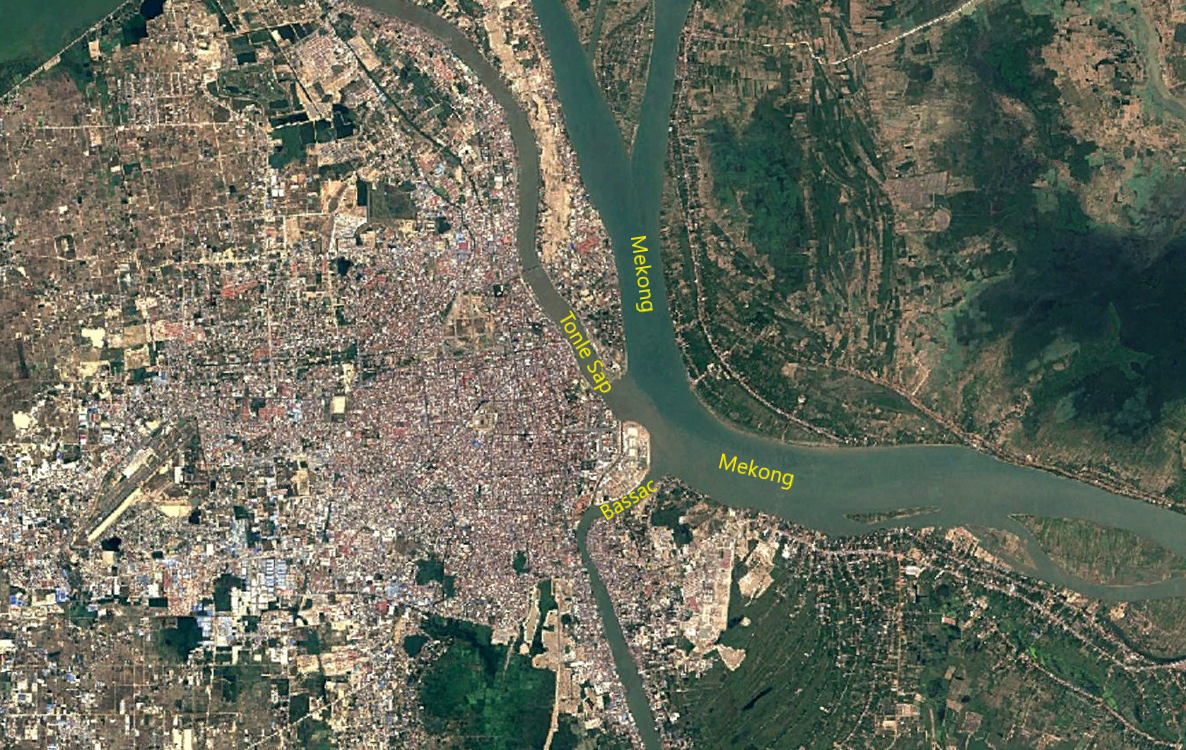Location
Cambodia is a small country located in the Indochina Peninsula in Southeast Asia. It is neighbored by Thailand, Laos, and Vietnam. Some major bodies of water include the Gulf of Thailand, which forms its southwestern border, and Tonle Sap Lake and the Mekong River, which both play a major role in the culture and lifestyle of the Khmer people. Cambodia’s unique location at the approximate center of the Indochina Peninsula places it at the border of two major cultural spheres, the Indosphere and the Sinosphere. The confluence of these combating cultures is reflected in comparing the writing systems of Cambodia and Vietnam: the Khmer alphabet developed from an ancient system used in India, whereas (before the 20th century) the Vietnam writing system was a set of Chinese characters.
 Map of Cambodia (courtesy of CIA World Factbook).
Map of Cambodia (courtesy of CIA World Factbook).Demographics
According the the CIA World Factbook, Cambodia is home to around 16.9 million people, 97.6% of whom are ethnically Khmer. Cambodia is a very young country, having 47.5% of the population under the age of 24 and a median age of 26.4. Compare this to the US which has 31.4% of people under 24 and a median age of 38.5 (and even the US relatively young compared to other Western nations)! Around 24.2% of the population live in cities, which means that Cambodia is still a very rural society.
The CIA Factbook indicates that 97.9% of the population is Buddhist (Theravada predominantly) and 0.5% Christian. Interestingly, the Joshua Project places the percent Buddhist significantly lower at 85.1% with 3.2% being Christian.
Climate
Compared to our home city Albany, Oregon, Cambodia is much more hot and humid! It is very common to see temperatures ranging between 70 and 95 degrees Fahrenheit. Albany, on the other hand, has average temperatures between 35 and 80 degrees.
Cambodia has two seasons: the dry and rainy seasons. The dry season lasts from December to April while the wet season lasts from May to November. During the wet season, the capital city, Phnom Penh, receives around 49 inches of rain! Inland cities such as Phnom Penh and Siem Reap receive around 55 inches of rain. Coastal cities like Sihanoukville receive much more rain (87 inches in fact)! On an aside, this is nothing compared to other places in SE Asia. Yangon receive almost 110 inches per year!
Geography
Phnom Penh is the captial city of Cambodia and is home to around 2.1 million people. This is by far the largest city in Cambodia and is the center of Khmer governance, culture, and commerce. Phnom Penh is located in a unique location at the confluence of the Mekong and Tonle Sap Rivers. Almost immediately after these two rivers merge to form a larger Mekong, it splits into the Bassac River. This makes Phnom Penh the city of Four Rivers.

Satellite Imagery of Phnom Penh (courtesy of Google Earth).
The Mekong River finds its origins in the Tibetan Plateau. The Tonle Sap begins (or ends) in Tonle Sap Lake. Every year, the flow rate of Mekong River increases due to heavy rainfall. In the capital, the river level can rise as much as 15 feet. This causes an interesting phenomenon: because the hydraulic gradient of the Mekong River is so high, the Tonle Sap river actually reverses in direction and flows north into Tonle Sap Lake, acting as a source rather than an outlet of water. Consequently, during the rainy season Tonle Sap Lake swells to massive proportions spreading across a massive floodplain, growing by almost 500%! The Tonle Sap River is the only one of its kind in the world.
Economy
The gross domestic product per capita (PPP) was estimated at $4,000 in 2017. While this is among the lowest in the world, GDP growth rate is steady around 7% per year.
Agriculture is one of the predominant sectors in the Khmer economy are agriculture (25.3%), employing 48.7% of the labor force. Cambodia’s primary agricultural products include rice, rubber, and corn. For your interesting trivia pleasure: Cambodia won the “World’s Best Rice Contest” at the World Rice Conference in 2012, 2013, 2014 and 2018! Like their neighbors, Cambodia boasts of a wide variety of fresh, tropical fruits. Yum! 
Display of beautiful tropical fruit from our 2016 trip.
Other important industries include tourism (more on this later), garments, and construction. Next time you purchase a t-shirt check the tag; there’s a chance that it was made in Cambodia! Garments account for 80% of Cambodia’s exports, a lot of which is sent to the US.
